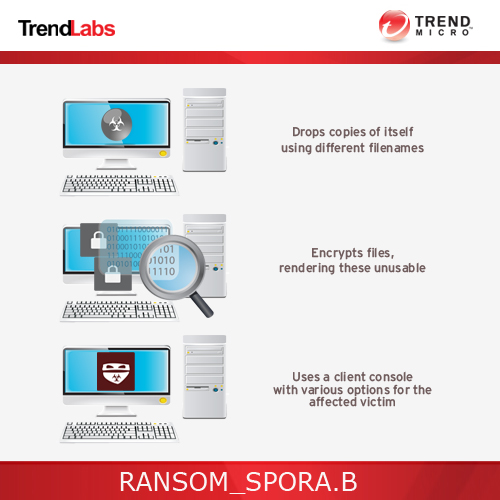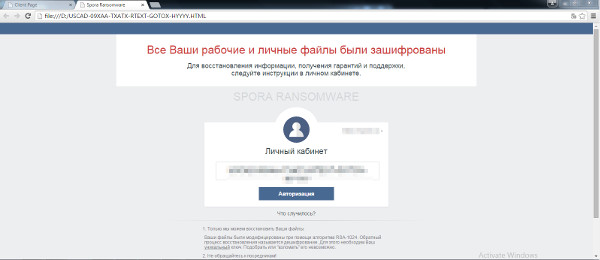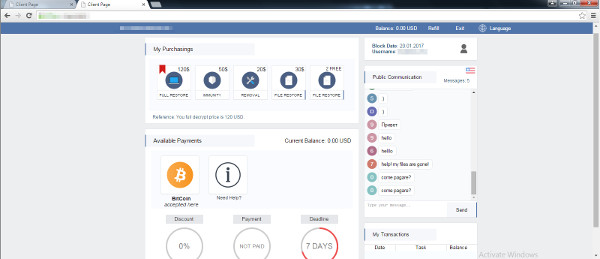RANSOM_SPORA.B
Ransom:Win32/Spora.A(Microsoft);
Windows


Threat Type: Trojan
Destructiveness: No
Encrypted: Yes
In the wild: Yes
OVERVIEW
This ransomware uses a client console, giving the affected user a variety of options. including a free trial individual file restore. These options vary in prices. Furthermore, the ransom note language adapts with country code.
To get a one-glance comprehensive view of the behavior of this Trojan, refer to the Threat Diagram shown below.

This Trojan arrives on a system as a file dropped by other malware or as a file downloaded unknowingly by users when visiting malicious sites.
TECHNICAL DETAILS
Arrival Details
This Trojan arrives on a system as a file dropped by other malware or as a file downloaded unknowingly by users when visiting malicious sites.
Installation
This Trojan drops a copy of itself in the following folders using different file names:
- %Desktop%{random values}.exe - set attributes to Hidden
- %AppDataLocal%\Temp\{random values}.exe
- {all removable and fixed drives}\{random values}.exe - set attributes to Hidden
(Note: %Desktop% is the desktop folder, where it usually is C:\Documents and Settings\{user name}\Desktop in Windows 2000, Windows Server 2003, and Windows XP (32- and 64-bit); C:\Users\{user name}\Desktop in Windows Vista (32- and 64-bit), Windows 7 (32- and 64-bit), Windows 8 (32- and 64-bit), Windows 8.1 (32- and 64-bit), Windows Server 2008, and Windows Server 2012.. %AppDataLocal% is the Application Data folder found in Local Settings, where it is usually C:\Documents and Settings\{user name}\Local Settings\Application Data on Windows 2000, Windows Server 2003, and Windows XP (32- and 64-bit); C:\Users\{user name}\AppData\Local on Windows Vista (32- and 64-bit), Windows 7 (32- and 64-bit), Windows 8 (32- and 64-bit), Windows 8.1 (32- and 64-bit), Windows Server 2008, and Windows Server 2012.)
It drops the following files:
- %Desktop%\{unique id}.HTML - ransom note
- %Desktop%\{unique id}.KEY
- %Application Data%\{unique id}.HTML - ransom note
- %Application Data%\{unique id}.KEY
- %Application Data%\{unique id}.LST
- %Application Data%\Microsoft\Windows\Templates\{unique id}.HTML - ransom note
- %Application Data%\Microsoft\Windows\Templates\{unique id}.KEY
- %Application Data%\Microsoft\Windows\Templates\{unique id}.LST
- {Fixed and Removable Drive Letter}:\{Shortcut files with the filename of every folder in the removable and fixed drive}
- The malware creates these shortcut files in order to trick the user due to its folder icon and legit filenames.
- The target path of these shortcuts is set to: %System%\cmd.exe /C explorer.exe "{folder name - where original files are stored}" & type "{random values}.exe - dropped copy of the malware" - "%tmp%\{random values}.exe - dropped copy of the malware" & start "{folder name - where original files are stored}" "%tmp%\{random values}.exe - dropped copy of the malware"
- %Application Data%\{10 digit number}
(Note: %Desktop% is the desktop folder, where it usually is C:\Documents and Settings\{user name}\Desktop in Windows 2000, Windows Server 2003, and Windows XP (32- and 64-bit); C:\Users\{user name}\Desktop in Windows Vista (32- and 64-bit), Windows 7 (32- and 64-bit), Windows 8 (32- and 64-bit), Windows 8.1 (32- and 64-bit), Windows Server 2008, and Windows Server 2012.. %Application Data% is the Application Data folder, where it usually is C:\Documents and Settings\{user name}\Application Data on Windows 2000, Windows Server 2003, and Windows XP (32- and 64-bit); C:\Users\{user name}\AppData\Roaming on Windows Vista (32- and 64-bit), Windows 7 (32- and 64-bit), Windows 8 (32- and 64-bit), Windows 8.1 (32- and 64-bit), Windows Server 2008, and Windows Server 2012.)
Other Details
This Trojan encrypts files with the following extensions:
- .backup
- .7z
- .rar
- .zip
- .tiff
- .jpeg
- .jpg
- .accdb
- .sqlite
- .dbf
- .1cd
- .mdb
- .cd
- .cdr
- .dwg
- .psd
- .odt
- .rtf
- .docx
- .xlsx
- .doc
- .xls
It does the following:
- This ransomware deletes all shadow copies by executing the following command:
- vssadmin delete shadows/all/quiet
- It prevents encrypting files containing any of the strings in its full path name:
- games
- program files (x86)
- program files
- windows
- It disables Windows Startup Repair by executing the following command:
- bcdedit.exe /set {default} recoveryenabled no
- bcdedit.exe /set {default} bootstatuspolicy ignoreallfailures
NOTES:
This ransomware displays the following images:


SOLUTION
Step 1
Before doing any scans, Windows XP, Windows Vista, and Windows 7 users must disable System Restore to allow full scanning of their computers.
Step 2
Note that not all files, folders, and registry keys and entries are installed on your computer during this malware's/spyware's/grayware's execution. This may be due to incomplete installation or other operating system conditions. If you do not find the same files/folders/registry information, please proceed to the next step.
Step 3
Restart in Safe Mode
Step 4
Search and delete this file
- %Desktop%\{unique id}.HTML
- %Desktop%\{unique id}.KEY
- %Application Data%\{unique id}.HTML
- %Application Data%\{unique id}.KEY
- %Application Data%\{unique id}.LST
- %Application Data%\Microsoft\Windows\Templates\{unique id}.HTML
- %Application Data%\Microsoft\Windows\Templates\{unique id}.KEY
- %Application Data%\Microsoft\Windows\Templates\{unique id}.LST
- {Fixed and Removable Drive Letter}:\{Shortcut files with the filename of every folder in the removable and fixed drive}
Step 5
Restart in normal mode and scan your computer with your Trend Micro product for files detected as RANSOM_SPORA.B. If the detected files have already been cleaned, deleted, or quarantined by your Trend Micro product, no further step is required. You may opt to simply delete the quarantined files. Please check this Knowledge Base page for more information.
Step 6
Restore encrypted files from backup.
Did this description help? Tell us how we did.

